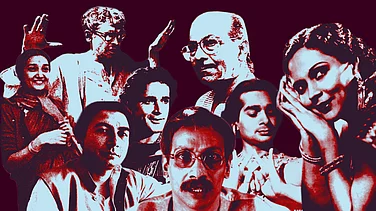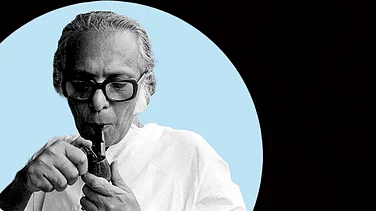LIKE a wise old spider Zohra Sehgal lies waiting to net little flies like me. When I rang the other day to request an interview she said, "Ah, magazine interview. But for such things I charge a fee," and mentioned a figure, not too large but not too small. Her wonderful, big laugh, something between a gurgle and a guffaw, filled the earpiece. "It's fine for fellows like you to ask," she added, "but I'm 85 and have to start saving for my funeral."
The incident put me in mind of a similar demand in London, years ago, when an English magazine asked me to interview Lady Diana Cooper, the celebrated wit and beauty. "Be delighted to see you," piped Lady Diana in her high aristocratic voice. "But it'll be £100 for the hour." The English magazine was less generous than Outlook with Zohra Sehgal—its editor suggested I get a quote over the telephone. "Quote?" asked Lady Diana, a withering note creeping into her tone when I called back. "Stop badgering me, young man, because I just gave you my quote."
It is not that grand old ladies are particularly avaricious and have their collection box ready at the first salaam. It is that they feel the need to patent the extraordinary events of their lives. If people want to purloin bits and pieces of a life that they have struggled so long and hard to turn into an art from, they must learn to pay. Zohra Sehgal is unquestionably one of India's greatest living stage actresses. She started her professional career in 1935 as a leading dancer with the Uday Shankar Ballet Company and travelled the world from the North Cape to the Nile, from San Fransisco to Penang ("Robu was just a small sickly boy on stage. Whoever thought he would become the great Ravi Shankar?").
Then, in 1945, she joined Prithviraj Kapoor's Prithvi Theatre as an actress on a salary of Rs 400 a month. For 14 years she toured every corner of India in the most successful example of a travelling repertory in modern theatre. The experience made her sister Uzra Butt and her national stars. In between she married a fellow dancer, Kameshwar Sehgal, and lived through his suicide.
Moving to Britain in 1962 on a drama scholarship, she stayed on to educate her two children. Jobless and broke, she eked out a living as a dresser in London's greenrooms and tailoring establishments for 10 years. But from the late 1970s onwards, British TV and films rediscovered her in a big way. A star was reborn in serials such as Jewel in the Crown and Tandoori Nights and in films such as Bhaji on the Beach.
Hers is a truly amazing story and she has put much of it in her memoir titled Stages: The Art & Adventures of Zohra Sehgal (Kali for Women, 238 pages, Rs 300). It's compulsory reading for anyone interested in the history of the performing arts in India but, as biographies go, it is not a very good example. Joan Erdman, the American academic who helped Sehgal write it, has treated it as an experiment in "oral biography" (Erdman's tiresome foreword and afterword are to be ignored). The text is often repetitive and, for a book filled with stories about some of the greatest names of the stage and screen that she had originally wanted to call The Namedropper, there is no index.
And Sehgal herself, justly famous for her candour, gets cagey about those parts of her life that were either too tempestuous or painful. For instance, Uday Shankar was a genius but he was also a chronic womaniser and drunk, and they had a passionate affair when they went off to Bali for three months in 1938, but she does not tell it like it was. She leaves out her battle with cancer in later years. And although she admits that her sister Uzra (who married Salman Rushdie's uncle Hamid Butt) occupied the same place in Prithviraj Kapoor's life that Nargis did in Raj Kapoor's (of muse, leading lady and the great love of his life), the book is silent about the relationship.
"I know the dead don't libel and in 1997 these things don't matter," she says. "But there were two things that restrained me. I had no wish to offend the families of the people concerned. And even in those days, these were very complex relationships." Here she switches from English to Hindustani, settling the issue with a penetrating look and an elegant metaphor. "How do you take apart each thread of a life when you want to convey its texture. There is always the danger of tearing the fabric by mistake."
But her rebellious Pathan nature, her cast-iron self-control and wicked self-deprecating humour—above all, her uncompromising devotion to her art—come through forcefully in the book. Unexpected things happened to her from an early age. At the age of seven she was sent off to a purdah boarding school in Lahore, in itself an unusual happening in 1919 but unheard of among UP's Muslim aristocracy. Donning a beige silk burqa in 1930, she set off for Europe by road with her uncle, with the tacit understanding of marrying his son, then an undergraduate at Oxford. To escape the eventuality she dropped off at Dresden and learnt dance for two years.
On her return home she met Uday Shankar. "I was a terrific snob. He was a great dancer but I still thought of him as a dhoti-chappal type. I did something terrible to him once in Calcutta. He was pestering me for attention, so to put him off I stepped with my stiletto heel hard on his foot and ground it in." Unlike her sister Uzra, Zohra never had the looks. Her daughter Kiran Sehgal, the classical dancer, remembers her mother often saying, "You are seeing me now, when I am old and ugly; you should have seen me then, when I was young and ugly." The reason she never got parts in Hindi films is because "they want even the mothers to look sexy and beautiful. I had a flat chest, big hips, lousy looks". But for all its hardship, the move to England resurrected her career. "If I had stayed on hereIwould have fizzled out." Now she is back in Delhi forever. Her plan was to live a quiet retired life near her family and prepare for the quietus of the grave. But this being Zohra Sehgal's life, the unexpected has stepped in. She has more offers of work and money today than at any other stage of her life. "I go through my handbags to match them with my sari and, in each, I find little bundles of notes. Goodness, can you believe it, me and little bundles? Me who used to hunt London down to look for the cheaper loaf of bread?"
To help the photographer along she sat, this little, old lady on a sofa, and began to softly recite from the Urdu poets. Faiz Ahmed Faiz, Majaz, Iqbal, Ali Sardar Jafri and KaifiAzmi. But soon she was raising a storm and as she ended with Hafeez Jalandhri's famous lyric, Abhi to main jawan hoon, which she can recite like no other, the photographer was begging her for repeat takes and she was begging the photographer to stop wasting film. How fitting, I thought, that unlike actresses who pay publicists to have their interviews published in magazines, magazines pay Zohra Sehgal for interviews. Vive la difference!






















